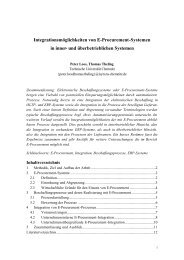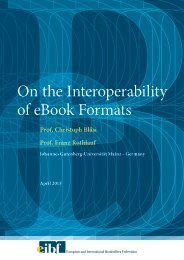Hedonic and Utilitarian Motivations of Social Network Site Adoption
Hedonic and Utilitarian Motivations of Social Network Site Adoption
Hedonic and Utilitarian Motivations of Social Network Site Adoption
Create successful ePaper yourself
Turn your PDF publications into a flip-book with our unique Google optimized e-Paper software.
Figure 1. Technology-Acceptance-Model. 1<br />
Construct<br />
Definition<br />
Actual System Use Refers to a person’s actual use <strong>of</strong> an information technology (Straub et al., 1995).<br />
Behavioral “[Behavioral] Intentions … capture the motivational factors that influence a<br />
Intention to Use [person’s] behavior; they are indications <strong>of</strong> how hard people are willing to try, <strong>of</strong><br />
how much <strong>of</strong> an effort they are planning to exert, in order to perform the behavior”<br />
(Ajzen, 1991, p. 181).<br />
Perceived Ease <strong>of</strong> “[T]he degree to which a person believes that using a particular system would be<br />
Use<br />
Perceived<br />
Usefulness<br />
Table 1.<br />
free <strong>of</strong> effort” (Davis, 1989, p. 320).<br />
“[T]he degree to which a person believes that using a particular system would<br />
enhance his or her job [<strong>and</strong> task] performance” (Davis, 1989, p. 320).<br />
Definitions <strong>of</strong> TAM’s Constructs.<br />
Specifically, TAM builds a complete causal chain “linking external variables to … [an information<br />
technology’s] … actual use [in a work environment]” (Davis <strong>and</strong> Venkatesh, 1996, p. 20): it<br />
assumes that there is a causal relationship between the Behavioral Intention to Use <strong>and</strong> actual usage<br />
behavior (Fishbein <strong>and</strong> Ajzen, 1975; Ajzen <strong>and</strong> Fishbein, 1980; Ajzen, 1991). Behavioral Intention<br />
to Use is in turn directly determined by the Perceived Usefulness <strong>of</strong> an information technology <strong>and</strong><br />
its Perceived Ease <strong>of</strong> Use; Perceived Usefulness also mediates the effect <strong>of</strong> Perceived Ease <strong>of</strong> Use.<br />
As described earlier, TAM’s initial focus lay on information technologies designed for work<br />
environments. These naturally “aim to provide instrumental value to the user” (Van der Heijden,<br />
2004, p. 696) <strong>and</strong> are called utilitarian systems. Consistent with this utilitarian context, Perceived<br />
Usefulness centers on the motivations <strong>and</strong> benefits that are external to the system-user interaction<br />
itself, referred to as extrinsic motivations (Brief <strong>and</strong> Aldag, 1977; Van der Heijden, 2004). For<br />
example, the external benefits/extrinsic motivations <strong>of</strong> a text-processing program can be to foster a<br />
1 Based on the Theory <strong>of</strong> Reasoned Action, Davis et al. (1989) initially included Attitude Toward Using [“[T]he degree to<br />
which a person has a favorable or unfavorable evaluation or appraisal <strong>of</strong> the [usage] behavior” (Ajzen, 1991, p. 188)], as a<br />
mediator between the two personal beliefs <strong>and</strong> Behavioral Intention to Use into the TAM. However, it was dropped in<br />
later versions because <strong>of</strong> its low predictive value (Davis et al., 1992; Venkatesh <strong>and</strong> Davis, 2000; Venkatesh et al., 2003;<br />
Venkatesh <strong>and</strong> Bala, 2008). Henceforth, in contrast to the Theory <strong>of</strong> Reasoned Action, personal beliefs, included in the<br />
TAM, were generally understood as direct antecedents <strong>of</strong> the Behavioral Intention to Use.<br />
4







